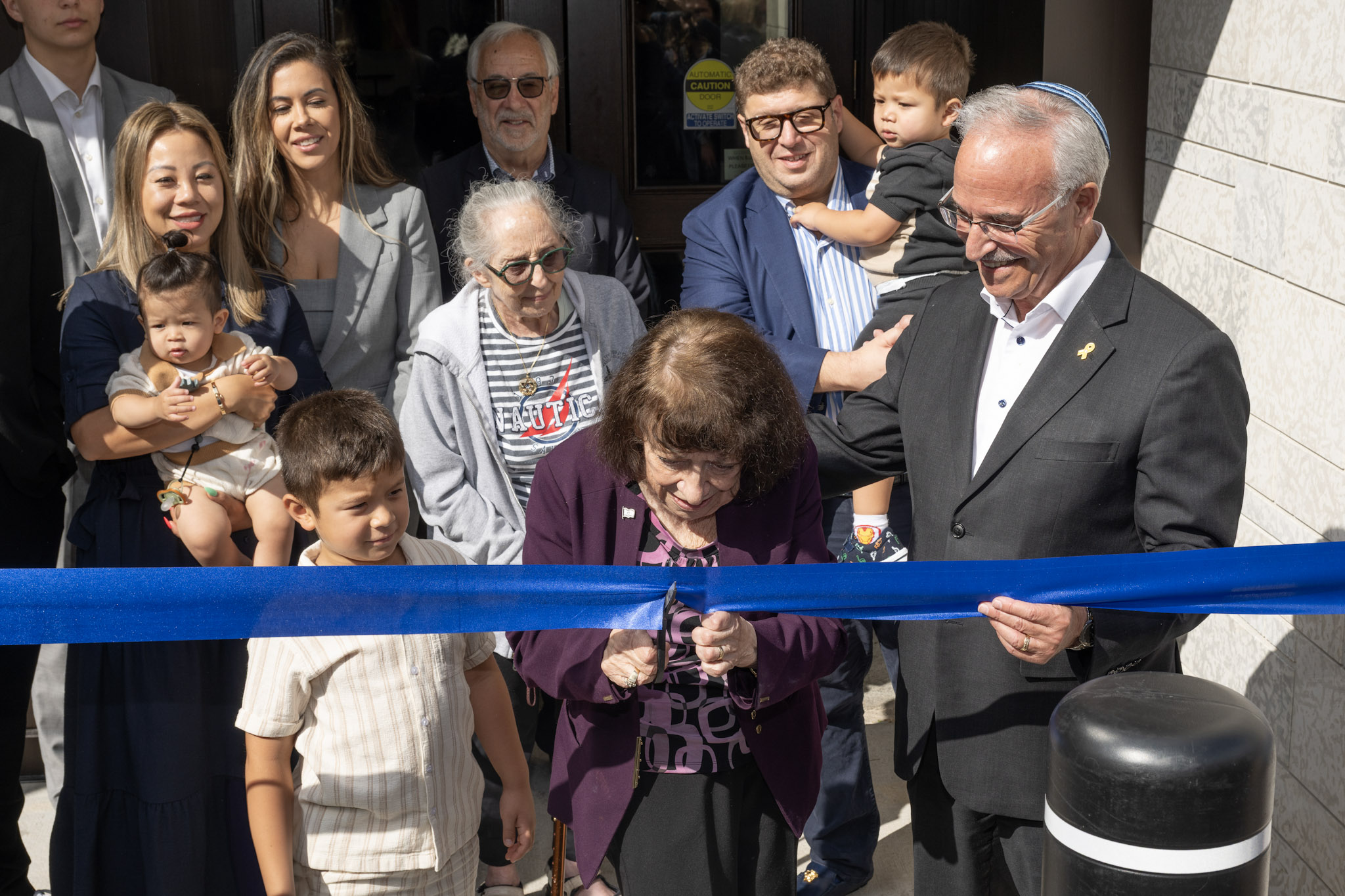Local News
The accidental killing of hostage Alon Shamriz resonated with me in an unexpected way

By BERNIE BELLAN As we near year’s end we are still living through what is arguably the most difficult period in Israel’s history since the War of Independence in 1948. Israelis are caught in between two competing – and probably incompatible goals: to free the remaining hostages held by Hamas and to eliminate Hamas permanently as a threat.
The mistaken killing of three Israeli hostages by the IDF brought home the incredibly difficult task the IDF faces in trying to wage war while at the same time finding and rescuing the remaining hostages.
When I heard the names of the three hostages who were mistakenly tragically shot by a member of the IDF this past week, one of the names immediately caught my attention: Alon Shamriz. Just a week prior, on December 7, I had received a phone call from David Horowitz, editor of the Times of Israel, about Shamriz.
What Horowitz told me was that our website, jewishpostandnews.ca, had posted a story about Alon Shamriz which, Horowitz said, had to come down immediately. I should explain that our website receives news stories from a number of other websites, which offer news feeds that are aggregated into our own site on a continuing basis – without me actually screening those stories beforehand.
The story about Shamriz, Horowitz explained, had to be removed because it posed a danger to Shamriz, should his Hamas captors happen to see it. The story was headlined: “Taken captive, Along Shamriz eliminated a terrorist before capture.” Shamriz’s family was rightly concerned that, if Hamas were to see that story they would exact revenge upon Shamriz – and kill him.
To be honest, I hadn’t noticed that story in our news feed and it wasn’t on our home page but, as Horowitz further explained, if anyone were to do a Google search for Alon Shamriz that story would appear in the Google search results.
Naturally, I acceded to Horowitz’s request immediately, but I noticed, when I did my own search for Alon Shamriz, that the same story appeared on a number of other websites. (I suppose Horowitz spent some time that day trying to contact every other website that also had the story on their site.) In addition, the next morning I received an email from Horowitz thanking me for removing the story from our site, but also asking me whether I could “scrub” it from Google. His email explained that even though the story was gone, if one did a Google search, the headline for the story would still show up in the search results. So, I set out “scrubbing” the story from Google. (Needless to say, I had to educate myself on that process.)
What all this did is bring home for me in a way that I never expected how intertwined we all are as a result of the internet. To think: A terrorist in Gaza might see something on the jewishpostandnews.ca website and want to kill a hostage as a result. That was quite unnerving. No matter how inadvertent and unlikely the possibility of that happening might have been, I acted as quickly as I could – and kept my mouth shut about what had happened. And then – word emerged that Alon Shamriz, whose name had just been brought to my attention, was dead – not at the hands of Hamas, which is what I feared might happen as a result of that story, but through the gross negligence of an Israeli soldier who completely disregarded the IDF’s rules of engagement.
Which brings me to the issue of the hostages – and what Israel can – and should do, to free them.
In our October 25 issue I wrote that “revenge is not a good military strategy.” As much as Netanyahu and his war cabinet still seem bent on “eradicating” Hamas, the closest scenario that bears some resemblance to what the IDF is attempting to accomplish in Gaza occurred in Mosul, Iraq, from November 2016 to July 2017 when a number of different forces made up primarily of Iraqis, but also a large number of Kurds, engaged in urban warfare with members of ISIS similar to what is now happening with the IDF and Hamas.
Of course, the Iraqi forces were nothing like what the IDF has. Many of them were poorly trained and overall, they were lacking coordination. The Iraqis and their Kurdish allies took over 10,000 casualties – and here’s something else that’s of tremendous significance: There were over 10,000 civilian casualties in Mosul, as ISIS used civilians as human shields – just as Hamas has always done and is doing as I write this.
And yet, with the war in Gaza now in its third month, and with Israel’s Defense Minister Yosi Gallant saying the war will continue until at least until February, one has to ask: At what cost?
Israel’s image in the world, as a result of thousands of Palestinian casualties, has been tarnished to the point where it has lost support from governments that had previously jumped to Israel’s defense, including our own Canadian government.
But, even worse, what of the ongoing psychological – and physical toll, that this prolonged war, is having on Israelis themselves? As psychologist Orly Dreman writes so eloquently – and passionately, in a piece in this issue, the trauma inflicted on Israelis, which is continuing every day, is immense. As Orly writes: “People are getting chest pain, stomach aches, headaches, back pains all stemming from stress. They obsessively check ten times that the door is locked and sleep with the lights on. We all have a sense of existential threat and that we feel powerless. The whole country was exposed to what happened either directly or indirectly. We are traumatized but being partners to the same fate we desperately cling together for support.”
But, with a failed Prime Minister at the helm who seems to be concerned more with his own political survival than anything else, and who, for weeks on end, avoided meeting with the families of hostages, Israel is faced with an intractable situation: Either continue a war, but with one hand tied behind its back as American pressure to reduce civilian casualties means that the IDF is bound to start taking more casualties of its own, or accept calls for at least a long-lasting truce that could lead to the eventual freeing of all the hostages.
In the meantime, we here in the diaspora are continuing to see the fallout from the displacement and deaths of so many Palestinian civilians. The metaphorical battleground here has been primarily on university campuses and, as we’ve noted in many articles within these pages over the past two and a half months, the hypocrisy of both students and professors in assailing Israel while completely ignoring the barbarity of Hamas is unconscionable.
We were recently sent a link to a Youtube video of comedian – and social commentator, Bill Maher’s most recent “New rules” segment of his weekly show (which aired December 15). In the segment (which we have elsewhere on this website at https://jewishpostandnews.ca/uncategorized/bill-maher-tells-it-like-it-is-when-it-comes-to-what-the-river-to-the-sea-really-means/, Maher offers devastatingly wittingly commentary on the abject ignorance of left wing critics of Israel. Maher is fearless in cutting through the phoniness of dogma, whether it’s coming from the right or, as we’ve seen so continually lately, the left, when it comes to heaping scorn on Israel. In this particular segment, which is about eight minutes long, one by one, Maher points out the intellectual weaknesses of the usual arguments being trotted out to justify condemnation of Israel on the world stage. In one particular clip he hones in on the phrase “from the river to the sea” and asks just where are the Jews in Israel supposed to go? (His suggested answer is quite hilarious, but I’ll leave it to you to watch the entire segment. Just go to Youtube and enter: “Bill Maher: From the River to the Sea.”)
One final note: As I note in another story on this site about the Jewish Federation’s recently held Annual General Meeting (https://jewishpostandnews.ca/faqs/rokmicronews-fp-1/jewish-federation-of-winnipeg-reports-a-surplus-for-the-2022-23-fiscal-year/), this past month saw the completion of Gustavo Zentner’s term as Federation President. Our community has been most fortunate to have had Gustavo in that position, not only for the tremendous contribution he has made to streamlining so much of the Federation’s operations and putting it on a very stable path going forward, but in particular, for his having stepped forward to lead this community these past two months in what has been a most difficult period. Gustavo’s eloquence, which has often been put to the test at a series of rallies called to bring us together since October 7, has been inspirational. When events called for a leader, Gustavo Zentner stepped up and we are all in his debt. Thank you Gustavo.
Local News
Thank you to the community from the Chesed Shel Emes

We’re delighted to share a major milestone in our Capital Campaign, “Building on our Tradition.” Launched in November 2018, this campaign aimed to replace our outdated facility with a modern space tailored to our unique needs. Our new building is designed with ritual at its core, featuring ample preparation space, Shomer space, and storage, creating a warm and welcoming environment for our community during times of need.
We’re grateful to the nearly 1,000 generous donors who contributed over $4 million towards our new facility. A $750,000 mortgage will be retired in November 2025, completing this monumental project in just seven years.
We’re also thrilled to announce that our Chesed Shel Emes Endowment Fund has grown tenfold, from $15,000 to $150,000, thanks to you, the Jewish Foundation of Manitoba’s FundMatch program, and Million Dollar Match initiative in 2024. Our fund helps ensure that everyone can have a dignified Jewish funeral regardless of financial need.
As we look to the future, our goal remains to ensure the Chevra Kadisha continues to serve our community for generations to come. Our focus now shifts to replenishing our savings account and growing our JFM Endowment fund.
We’re deeply grateful for your support over the past several years.
It’s our privilege to serve our community with care and compassion.
With sincere appreciation,
Campaign cabinet: Hillel Kravetsky, Gerry Pritchard, Stuart Pudavick,
Jack Solomon, and Rena Boroditsky
Murray S. Greenfield, President
Local News
Winnipeg Beach Synagogue about to celebrate 75th anniversary

By BERNIE BELLAN (July 13) In 1950 a group of cottage owners at Winnipeg Beach took it upon themselves to relocate a one-room schoolhouse that was in the Beausejour area to Winnipeg Beach where it became the beach synagogue at the corner of Hazel and Grove.
There it stayed until 1998 when it was moved to its current location at Camp Massad.
On August 2nd members of the synagogue will be holding a 75th anniversary celebration.

As part of the celebration anyone who is a descendant or relative of any of the original members of the first executive committee (as seen in the photo here) is invited to attend the synagogue that morning.
If you are a relative please contact Abe Borzykowski at wpgbeachshule@shaw.ca or aborzykowski@shaw.ca to let Abe know you might be attending or for more information about the 75th anniversary celebration.
We will soon be publishing a story about the history of the beach synagogue, which is something I’ve been writing about for over 25 years.
Local News
Vickar Family cuts ribbon on new Tova Vickar and Family Childcare Centre

By MYRON LOVE In the words of Larry Vickar, the Shaarey Zedek’s successful Dor V’ Dor Campaign “is not only a renewal of the synagogue but truly a renewal movement of Jewish life in our community.”An integral part of that renewal movement was the creation of a daycare centre within the expanded synagogue. On Monday, June 23, Larry and Tova Vickar cut the ribbon, thereby officially opening the Tova Vickar and Family Childcare Centre in the presence of 100 of their family members, friends and other supporters of the project.
The short program preceding the morning ribbon-cutting began with a continental breakfast followed by a welcome by both Fanny Levy, Shaarey Zedek’s Board President, and Executive Director Dr. Rena Secter Elbaze. In Elbaze’s remarks, she noted that Larry and Tova wanted their family (including son Stephen and family, who flew in from Florida) and friends at the event to celebrate the opening of the Tova Vickar and Family Childcare Centre, “not because of the accolades, but because, as Larry put it, he hopes that their investment in the congregation will inspire others to do the same.”
“When Larry and I spoke about what this gift meant to him and the message he wanted people to take away,” she continued, “I couldn’t help but connect it to the teachings of Reb Zalman Schachter-Shalomi whose book – Age-ing to Sage-ing – changes the whole way we look at the concept of ageing and basing it on our ancestral teachings.”
She explained that his concept of “Sage-ing” is based on three key ideas – Discover your meaning and purpose; accept our mortality and think about the legacy you want to leave.
“Larry spoke about these exact concepts when we met,” she said.
Elbaze also noted the presence of Shaarey Zedek’s newly-arrived senior Rabbi Carnie Rose, former Rabbi Alan Green, and area MLAs Mike Moroz and Carla Compton.
Larry Vickar expressed his great appreciation for all those in attendance. “Tova and I are deeply moved to stand here with you today for this important milestone in our community”, he said. “We are grateful to be surrounded by all of you, the people we care about, our family and friends… you who have touched our lives and played some part in our journey.”
